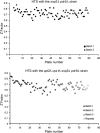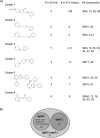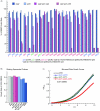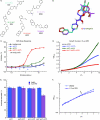A high-throughput screen for chemical inhibitors of exocytic transport in yeast
- PMID: 20461743
- PMCID: PMC3090732
- DOI: 10.1002/cbic.200900681
A high-throughput screen for chemical inhibitors of exocytic transport in yeast
Abstract
Most of the components of the membrane and protein traffic machinery were discovered by perturbing their functions, either with bioactive compounds or by mutations. However, the mechanisms responsible for exocytic transport vesicle formation at the Golgi and endosomes are still largely unknown. Both the exocytic traffic routes and the signaling pathways that regulate these routes are highly complex and robust, so that defects can be overcome by alternate pathways or mechanisms. A classical yeast genetic screen designed to account for the robustness of the exocytic pathway identified a novel conserved gene, AVL9, which functions in late exocytic transport. We now describe a chemical-genetic version of the mutant screen, in which we performed a high-throughput phenotypic screen of a large compound library and identified novel small-molecule secretory inhibitors. To maximize the number and diversity of our hits, the screen was performed in a pdr5Delta snq2Delta mutant background, which lacks two transporters responsible for pleiotropic drug resistance. However, we found that deletion of both transporters reduced the fitness of our screen strain, whereas the pdr5Delta mutation had a relatively small effect on growth and was also the more important transporter mutation for conferring sensitivity to our hits. In this and similar chemical-genetic yeast screens, using just a single pump mutation might be sufficient for increasing hit diversity while minimizing the physiological effects of transporter mutations.
Figures








Similar articles
-
A chemical genetic screen for modulators of exocytic transport identifies inhibitors of a transport mechanism linked to GTR2 function.Eukaryot Cell. 2010 Jan;9(1):116-26. doi: 10.1128/EC.00184-09. Epub 2009 Nov 6. Eukaryot Cell. 2010. PMID: 19897736 Free PMC article.
-
Avl9p, a member of a novel protein superfamily, functions in the late secretory pathway.Mol Biol Cell. 2007 Apr;18(4):1203-19. doi: 10.1091/mbc.e06-11-1035. Epub 2007 Jan 17. Mol Biol Cell. 2007. PMID: 17229886 Free PMC article.
-
Yeast-based high-throughput screen identifies Plasmodium falciparum equilibrative nucleoside transporter 1 inhibitors that kill malaria parasites.ACS Chem Biol. 2015 Mar 20;10(3):775-83. doi: 10.1021/cb500981y. Epub 2015 Jan 30. ACS Chem Biol. 2015. PMID: 25602169 Free PMC article.
-
Protein transport from the late Golgi to the vacuole in the yeast Saccharomyces cerevisiae.Biochim Biophys Acta. 2005 Jul 10;1744(3):438-54. doi: 10.1016/j.bbamcr.2005.04.004. Biochim Biophys Acta. 2005. PMID: 15913810 Review.
-
Retrograde trafficking and plasma membrane recycling pathways of the budding yeast Saccharomyces cerevisiae.Traffic. 2020 Jan;21(1):45-59. doi: 10.1111/tra.12693. Epub 2019 Oct 1. Traffic. 2020. PMID: 31471931 Review.
Cited by
-
Functional genomics in the study of yeast cell polarity: moving in the right direction.Philos Trans R Soc Lond B Biol Sci. 2013 Sep 23;368(1629):20130118. doi: 10.1098/rstb.2013.0118. Print 2013. Philos Trans R Soc Lond B Biol Sci. 2013. PMID: 24062589 Free PMC article. Review.
-
Adapting high-throughput screening methods and assays for biocontainment laboratories.Assay Drug Dev Technol. 2015 Jan-Feb;13(1):44-54. doi: 10.1089/adt.2014.617. Assay Drug Dev Technol. 2015. PMID: 25710545 Free PMC article. Review.
-
A histone deacetylase-dependent screen in yeast.Bioorg Med Chem. 2010 Nov 1;18(21):7586-92. doi: 10.1016/j.bmc.2010.08.045. Epub 2010 Sep 20. Bioorg Med Chem. 2010. PMID: 20863708 Free PMC article.
-
hsa_circ_0058357 acts as a ceRNA to promote non‑small cell lung cancer progression via the hsa‑miR‑24‑3p/AVL9 axis.Mol Med Rep. 2021 Jun;23(6):470. doi: 10.3892/mmr.2021.12109. Epub 2021 Apr 21. Mol Med Rep. 2021. PMID: 33880595 Free PMC article.
References
Publication types
MeSH terms
Substances
Grants and funding
LinkOut - more resources
Full Text Sources
Other Literature Sources
Molecular Biology Databases

